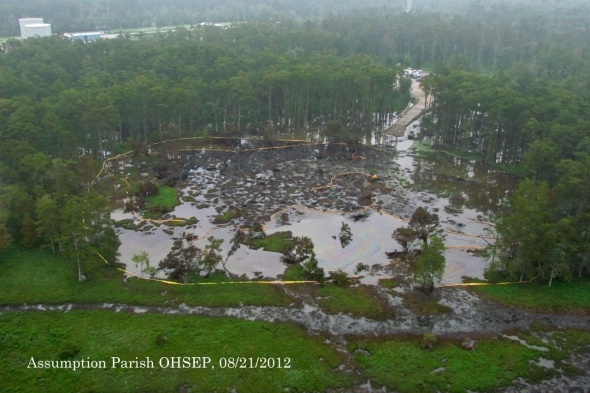Environmental health risks detailed at Louisiana bayou sinkhole disaster site

An environmental advocacy group has released analyses of state air and water sampling data collected at the site of the Texas Brine salt cavern sinkhole where radioactive oil drilling waste and other potentially toxic materials were stored in rural Assumption Parish, La.
The samples show the presence of various health-damaging chemicals, though at levels that are not likely to cause health problems -- at least in the short term.
"The concentrations of the chemicals contaminating the air in the residential area are below acceptable standards," according to a release from the Louisiana Environmental Action Network. However, LEAN says the chemicals' potential cumulative health impacts justify continued monitoring.
The Louisiana Department of Environmental Quality (DEQ) has been performing testing in and around the sinkhole, which appeared earlier this month on Bayou Corne following months of mysterious tremors, diesel odors and gas bubbles in the surrounding swamp. About 150 households are now under an evacuation order, and it's unclear when residents will be able to return home. Last week the sinkhole suddenly grew by about 50 feet, leading to the dramatic rescue of two cleanup workers before their boat was swallowed up.
Texas Brine has begun drilling an observational well to figure out what's happening inside the cavern. In addition, Crosstex Energy of Dallas has started moving liquid butane from a storage cavern near the sinkhole. The site is part of the Napoleonville Dome, a geologic salt formation that Houston-based Texas Brine mined to provide salt for industries that use it in chemical processes. The Gulf Coast is a major salt dome center.
The water in the sink hole is contaminated with diesel fuel, which is floated atop brine in salt caverns to prevent erosion, as well as diesel contaminants such as volatile organic chemicals, ethyl benzene, toluene and xylene. It's also contaminated with cancer-causing polycyclic aromatic hydrocarbons including naphthalene, anthracene and pyrene.
Air tests near the sinkhole and downwind detected volatile organic chemicals including benzene, toluene, xylene, ethylbenzene and carbon tetrachloride -- but at levels below state standards designed to protect human health. The health impacts associated with chemicals detected in the air near the disaster site can cause respiratory and skin problems, dizziness, weakness, muscle aches and abdominal pain, while benzene is a known carcinogen.
DEQ has also been testing for naturally occurring radioactive materials (NORM) from oil drilling, which were stored in the salt caverns. The tests found that NORM was present, but at concentrations below acceptable limits, according to LEAN.
In samples taken from the sinkhole water at a depth of 80 feet, Radium-226 levels were 63.569 picoCuries per liter (pCi/L), while Radium-228 was was measured at 18.705 pCi/L. Surface water samples turned up Radium-226 at 6.512 pCi/L and Radium-228 at 1.778 pCi/L. The Environmental Protection Agency has established a maximum contaminant level for radium in public drinking water supplies of 5 pCi/L.
LEAN has developed an log for people living and working near the site to register odors and health symptoms; it's available online here. To see DEQ's air, soil and water monitoring test results, click here.
(Photo of Bayou Corne sinkhole by Assumption Parish Office of Homeland Security and Emergency Preparedness.)
Tags
Sue Sturgis
Sue is the former editorial director of Facing South and the Institute for Southern Studies.
